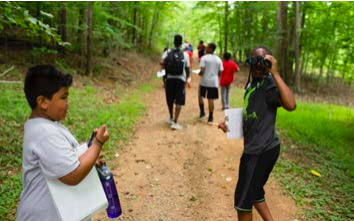As a TLC supporter, you know the benefits of nature and conservation. The many uses of outdoor spaces, from physical activity to growing produce, make the outdoors an essential part of our health and wellbeing. Last Fall in the Confluence and in the Fall 2017 Confluence, we outlined the history of land loss for people of color across the country and acknowledged the role that the conservation movement has played.
“When the conservation movement started, white people removed Indigenous people from their homes to create national parks. Today, Indigenous people live on a fraction of their land, and Black and Brown people own less than 2% of farmland. For decades, white people have dominated the conversations around outdoor recreation and limited access to outdoor space for minority people.”
There is a generally held notion that the outdoors are “for everyone,” but if you look closely, you’ll see it is an overwhelmingly White space.
Research confirms that people of color are far less likely to participate in nature-based outdoor recreation than their White counterparts. As TLC has tried to address this disparity, we have seen the ways in which Black, Indigenous, and other people of color have been intentionally marginalized from outdoor spaces. From the beginning, White settlers stole territories from Indigenous people and forced them from their native homelands. Later, they enslaved Black people and forced them to work on that very same land.
After the end of slavery and the Civil War, the outdoors remained a dangerous place for Black people; many were victim to racially motivated hate crimes, restricted from using public lands, or subject to inferior resources due to Jim Crow laws. Many formerly enslaved people and their descendants who later acquired land, eventually had their land taken from them through well-documented (but not always well known) violence, intimidation, and racist laws. Today, there continue to be countless, well-publicized examples of racism in outdoor spaces. As a result of this dark history and the challenges that continue through today, many people of color feel unwelcome, unsafe, and uncomfortable in the outdoors.
The response from our members to our letter last fall was overwhelmingly positive. One comment stood out: “I found it so fascinating the way you explained the origins of racial bias as connected with land ownership and preservation of natural areas. It makes complete sense when organizations that are working directly with marginalized people address the issue of racial inequities. You managed, to my surprise, to make the connection to TLC equally compelling…may we never, ever take our privilege for granted, even when it involves a serene walk in the woods.”
 While we outlined some of the work TLC has been doing to begin to address these inequities last fall, we realize racial equity efforts must be is ongoing – as will be our learning. We wanted to share some of what we have done in the past year.
While we outlined some of the work TLC has been doing to begin to address these inequities last fall, we realize racial equity efforts must be is ongoing – as will be our learning. We wanted to share some of what we have done in the past year.
TLC’s board continues efforts to maintain diversity among the 18 members – currently, we have 16 members who bring a range of expertise including business, forestry, conservation, finance, HR, and farming. They represent 5 of our 6 counties (with recruitment ongoing for two seats, which will ideally include a representative of Lee County), half are women and People of Color and White members are equally represented.
We’re investing time and resources into fostering and supporting the next generation of environmental professionals to increase and encourage racial diversity in the environmental field by supporting a paid internship program in collaboration with Knightdale High School and NC State. We are working more closely with partners like Outdoor Afro, Stagville State Historic Site, Duke University’s BOOST Program, and more. In the coming months, we will be doing more to amplify the amazing work of some of our community partners, who share our vision for a more inclusive and welcoming outdoors. Finally, consultants have almost completed a feasibility study for a Good Ground Initiative, which will use traditional land protection tools to protect more farmland and increase land ownership for people of color.
While there is a history of exclusion of communities of color in the outdoors, there is also a historical and deep-rooted connection to nature that has continued today. In America, Indigenous people are the original stewards of the outdoor spaces that we inhabit and enjoy today Indigenous ecological knowledge offers us some of the best practices for land management. Enslaved Black people that were forced to labor on the land developed a unique relationship with the outdoors, often seeking solace in nature or living off the land as a means of pursuing freedom. In our National Park System, some of the first Park Rangers were Buffalo Soldiers, an all-Black U.S. Army regiment that formed after the Civil War.
Today, National groups like Latino Outdoors, Outdoor Asian, Outdoor Afro, Natives Outdoors, and many more strive to connect People of Color to the outdoors to continue to build upon these legacies. At TLC, we hope to be able to uplift these efforts and provide access to opportunities to make the outdoors more equitable for all. While there is still a magnitude of work to be done, we hope that we can continue to make strides and push the boundaries of making our organization more inclusive.
If you have suggestions, questions, or areas of growth for our organization, we invite you to share them with us so we can better serve our communities.

